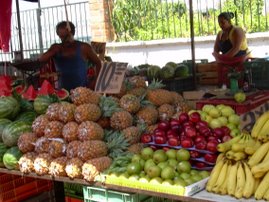Classes meet at various times during the week to accommodate different work schedules. My class met every Tuesday and Thursday from 5:30-7:00PM. Students range in age from 12 through adulthood. Learning English is popular here, obviously, because it improves one's job opportunities, since we have such a mixed community.
Believe it or not, I was nervous when I began teaching last September. My 31 years in the community college did not prepare me to walk into a room of Mexicans who spoke little or no English, and do a good job. Pixie had taught ESL, but I had not. I quickly learned, as anyone who works with these students does, that they are hardworking, courteous, and friendly. I think it helped that I was simultaneously struggling to learn Spanish; it gave us something in common.
Well, the year of working with these students has just ended, and I am very pleased with their progress. About 22 students started the program, but a majority dropped out because of work, family issues, or realizing that learning a new language can be daunting. Ten students officially completed the course and are ready to move on to level two. I am very proud of them and wanted to share a bit about them on this blog. Working with these students gave me a chance few other gringos here really have the opportunity to do: get to know young Mexicans in a more intimate way and learn a bit about their lives. The six students I introduce here are the six who showed up for pizza on the last class. The others were probably working or otherwise engaged, or they would certainly have shown up for free pizza.

Augustina was one of the older students and might be considered the "mother" of the group. She spoke more English than the others because she is married to an American. Her skills came in quite useful in class when we had to clarify something which my Spanish was insufficient for; she often explained what I was trying to say in Spanish for those who spoke no English at all. She would explain when another student was having a problem of some type. She was probably a bit advanced for level one, but wanted to improve her confidence.

Carmen is working at a local seafood restaurant which is especially popular with Guadalajarans. Since most of the clients are Mexican, she does not need much English. She is very shy about speaking English in class, but her written work is excellent which indicates to me that she is taking her work seriously and studying hard. She is very pleasant to have in class and seems to enjoy the interaction.

Ana Paula could probably win the award as my most enthusiastic student. She breezes into class each day with a broad smile and a "Hello Teacher!" (They all call me "teacher" even though I told them my name. It's a cultural sign of respect.) Ana Paula works as a teacher and administrator at a women's college for culinary arts and hospitality in Jaltepec, several towns west of Ajijic. She is extremely motivated and knows that a career in the hospitality field will require English. Her dad is Maggie's vet, a very nice man who has raised his children as a single parent. She plays cello and sings in a church chorus.

Abigail is a hardworking mother of several children who travels to class every day with her daughter who is also enrolled in a level one class. Abigail works for aprivately-funded organization called Ninos de Chapala y Ajijic (Children of Chapala and Ajijic) which provides services to children with special needs. She is a teacher who works every day with many of these children. she is often exhausted by the time she arrives at class, but she is always the first one to arrive, often with a bag of groceries to take home to her family on the bus after class. She has made excellent progress this year.

David (pronounced Da BEED, since the Mexicans pronounce v's as b's) is one of two twelve year olds who started the class. He is now thirteen. He is attending Secondario, which is equivalent to middle school. He is a very reticent young man, who is painfully shy and struggles to speak in class. Of course all the women in class love him and mother him. He does very well on all written work, so I know he's getting the idea quite well. He plays violin. I sometimes see him around the village carrying his violin case.

Maria Elena is a lovely young woman who joined the class around Christmas. She is the fiance of Augustina's son, and I think it was Augustina who recruited her to join the class. She worked very hard, showed up for almost every class prepared, and made fine progress. She is also shy about speaking, but worked hard to overcome this. She was pregnant during most of the class and had her baby, Gustavo, during the last few weeks of the course. She brought him to class last week. He's even younger than Isabelle.
There were four other students who finished the class but were not there for the final class, so I did not include their photos: Jose Antonio is a young construction worker who often wears a Yankees cap to class. We had a lot of joking about that. His brother Julio also works construction and is more quiet and serious. They both did very well in the class. Myra, a teacher from San Juan Cosala, had to miss a number of classes because of her job and during the mudslides in San Juan, but stayed with he class nevertheless. Finally, Karla is a young woman who consistently showed up for class even though she was also very shy about speaking. She was working at a local restaurant frequented by Americans and Canadians.
I will miss my students, but I am looking forward to getting a new group in the fall. I think it would be much more difficult to stay in touch with younger people unless I did something like this, and I am energized by the process.
We are settling back into our new house after our trip north and working on making it a home. The weather is very hot and dry, especially in the afternoons. Everyone is wiaiting for the rains which should arrive within the next few weeks.
I'll end with a poem I wrote recently about my experience with my class. One thing you need to know: Bimbo is a brand of bread (pan) in Mexico.
Learning English with the Gringo
They are patient with me
The gringo who no longer works
While they struggle to learn new sounds
Which hurt their mouths
So they can understand more clearly
What these old gringos really want.
On
Always pausing at the door, smiling
Until I invite them in
To join our loose group.
Sometimes in unison, articulating with wide mouths
Showing their teeth, but all together
So the sound is muddled to me.
“Que?” I ask; they obediently repeat
Until they are satisfied with my approximation.
As they try to fathom
Our language, where objects are sexless,
And pronunciation follows no rules.
“Not bideo,” I implore, “viiiideo!”
“Veeeedeo!” they repeat, eyes twinkling
Another “V” word for them to forget.
We come across “
“Heh heh,” chuckles Juan Jose, “Paris Heeeelton!”
“Oh,” I declare, “She’s a bimbo, you know.”
“Pan” they look bewildered?
“No,” I laugh, and swagger.
“This is a bimbo!”
They roar, and I love this moment.



































































No comments:
Post a Comment